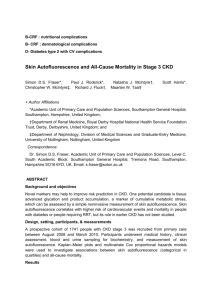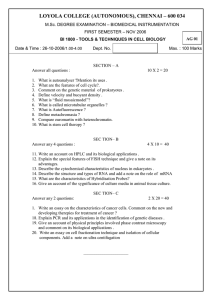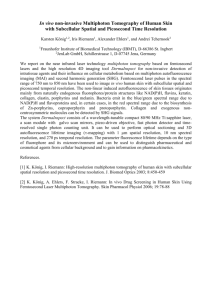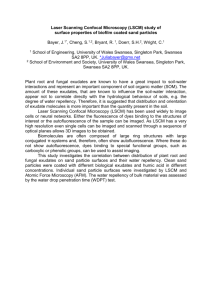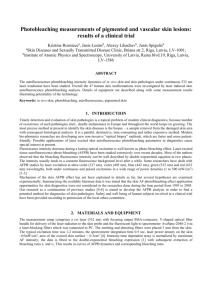The autofluorescence of plastic materials and chips
advertisement
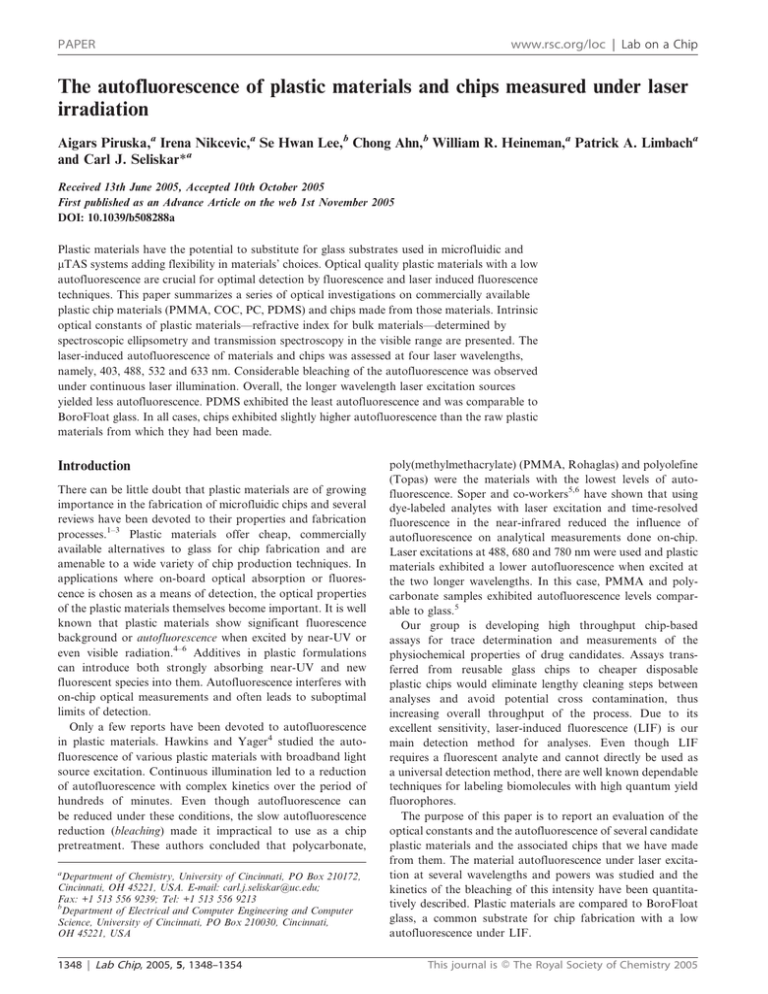
PAPER
www.rsc.org/loc | Lab on a Chip
The autofluorescence of plastic materials and chips measured under laser
irradiation
Aigars Piruska,a Irena Nikcevic,a Se Hwan Lee,b Chong Ahn,b William R. Heineman,a Patrick A. Limbacha
and Carl J. Seliskar*a
Received 13th June 2005, Accepted 10th October 2005
First published as an Advance Article on the web 1st November 2005
DOI: 10.1039/b508288a
Plastic materials have the potential to substitute for glass substrates used in microfluidic and
mTAS systems adding flexibility in materials’ choices. Optical quality plastic materials with a low
autofluorescence are crucial for optimal detection by fluorescence and laser induced fluorescence
techniques. This paper summarizes a series of optical investigations on commercially available
plastic chip materials (PMMA, COC, PC, PDMS) and chips made from those materials. Intrinsic
optical constants of plastic materials—refractive index for bulk materials—determined by
spectroscopic ellipsometry and transmission spectroscopy in the visible range are presented. The
laser-induced autofluorescence of materials and chips was assessed at four laser wavelengths,
namely, 403, 488, 532 and 633 nm. Considerable bleaching of the autofluorescence was observed
under continuous laser illumination. Overall, the longer wavelength laser excitation sources
yielded less autofluorescence. PDMS exhibited the least autofluorescence and was comparable to
BoroFloat glass. In all cases, chips exhibited slightly higher autofluorescence than the raw plastic
materials from which they had been made.
Introduction
There can be little doubt that plastic materials are of growing
importance in the fabrication of microfluidic chips and several
reviews have been devoted to their properties and fabrication
processes.1–3 Plastic materials offer cheap, commercially
available alternatives to glass for chip fabrication and are
amenable to a wide variety of chip production techniques. In
applications where on-board optical absorption or fluorescence is chosen as a means of detection, the optical properties
of the plastic materials themselves become important. It is well
known that plastic materials show significant fluorescence
background or autofluorescence when excited by near-UV or
even visible radiation.4–6 Additives in plastic formulations
can introduce both strongly absorbing near-UV and new
fluorescent species into them. Autofluorescence interferes with
on-chip optical measurements and often leads to suboptimal
limits of detection.
Only a few reports have been devoted to autofluorescence
in plastic materials. Hawkins and Yager4 studied the autofluorescence of various plastic materials with broadband light
source excitation. Continuous illumination led to a reduction
of autofluorescence with complex kinetics over the period of
hundreds of minutes. Even though autofluorescence can
be reduced under these conditions, the slow autofluorescence
reduction (bleaching) made it impractical to use as a chip
pretreatment. These authors concluded that polycarbonate,
a
Department of Chemistry, University of Cincinnati, PO Box 210172,
Cincinnati, OH 45221, USA. E-mail: carl.j.seliskar@uc.edu;
Fax: +1 513 556 9239; Tel: +1 513 556 9213
b
Department of Electrical and Computer Engineering and Computer
Science, University of Cincinnati, PO Box 210030, Cincinnati,
OH 45221, USA
1348 | Lab Chip, 2005, 5, 1348–1354
poly(methylmethacrylate) (PMMA, Rohaglas) and polyolefine
(Topas) were the materials with the lowest levels of autofluorescence. Soper and co-workers5,6 have shown that using
dye-labeled analytes with laser excitation and time-resolved
fluorescence in the near-infrared reduced the influence of
autofluorescence on analytical measurements done on-chip.
Laser excitations at 488, 680 and 780 nm were used and plastic
materials exhibited a lower autofluorescence when excited at
the two longer wavelengths. In this case, PMMA and polycarbonate samples exhibited autofluorescence levels comparable to glass.5
Our group is developing high throughput chip-based
assays for trace determination and measurements of the
physiochemical properties of drug candidates. Assays transferred from reusable glass chips to cheaper disposable
plastic chips would eliminate lengthy cleaning steps between
analyses and avoid potential cross contamination, thus
increasing overall throughput of the process. Due to its
excellent sensitivity, laser-induced fluorescence (LIF) is our
main detection method for analyses. Even though LIF
requires a fluorescent analyte and cannot directly be used as
a universal detection method, there are well known dependable
techniques for labeling biomolecules with high quantum yield
fluorophores.
The purpose of this paper is to report an evaluation of the
optical constants and the autofluorescence of several candidate
plastic materials and the associated chips that we have made
from them. The material autofluorescence under laser excitation at several wavelengths and powers was studied and the
kinetics of the bleaching of this intensity have been quantitatively described. Plastic materials are compared to BoroFloat
glass, a common substrate for chip fabrication with a low
autofluorescence under LIF.
This journal is ß The Royal Society of Chemistry 2005
Experimental
Materials
The following commercially available materials were used:
1 mm BoroFloat (Schott), 5.0, 3.0 and 0.25 mm poly(methylmethacrylate) (PMMA, GoodFellow), 0.25 and 2.0 mm
polycarbonate (PC, GoodFellow), poly(dimethylsiloxane)
(PDMS, Dow Corning Sylgard 184 kit). PDMS sheets were
made by mixing base to curing agent at a 10 : 1 ratio (w/w),
degassing, pouring into a Petri dish, and degassing again.
PDMS sheets obtained were cured on a hotplate for 2 h at
80 uC. 1 mm thick sheets from cyclic olefin copolymer (COC,
Topas) were made by injection molding (IM). COC, PMMA
(GE Polymerland) and PC (GE Plastic) chips were fabricated
using injection molding.7 Additionally, PMMA (GoodFellow)
chips were made by hot embossing (HE).
Transmission spectra of materials were recorded on a HP
8453 diode array spectrophotometer and refractive indices
determined on a variable angle spectroscopic ellipsometer
(J.A.Woollam, Inc.).
translated on the sample stage to ensure a fresh unbleached
sample spot for illumination. All measurements were done
with a 106 microscope objective and at 1, 3 and 5 mW laser
power at the sample. For thin samples (0.25 mm sheets)
locations of the sample bottom and top surfaces were
determined and the objective adjusted to focus light midway
between these surfaces.
To examine how the autofluorescence changed with microscope objective-to-sample distance the following procedure
was used. The sample was placed on the calibrated microscope
stage and the positions of the bottom and top sample surfaces
located. Then the objective was backed off from the sample
(image plane closer to the objective than the sample bottom
surface). The objective was then moved toward the sample
in 250 mm steps and the autofluorescence signal recorded
continuously.
The long term recovery of material autofluorescence was
examined in the following way. A sample was aligned and
illuminated for 10 min as described above. The same spot was
then illuminated for an additional 10 min approximately 12 h
later while recording the autofluorescence.
Laser-induced fluorescence instrumentation
Material autofluorescence was measured using a Nikon TE
2000 epifluorescence microscope equipped with a H6780-20
PMT module (Hamamatsu) and a CoolSnap HQ CCD camera
(Roper Scientific). Current from the PMT was amplified with
a SR570 (Stanford Research) low current preamplifier and
digitized using a PCI P6036 DAQ card (National Instruments)
with software written in LabView (National Instruments). The
CCD camera was interfaced with a personal computer through
a PCI card and data were acquired using MetaMorph
(Universal Imaging Corporation) software. Four lasers
(20 mW, 403 nm, IQ2C20 (PTI Inc.); 50 mW, 488 nm,
(Melles Griot); 20 mW, 532 nm, 85-GCB-020 (Melles Griot);
35 mW, 633 nm, 25LHP928-249 (Melles Griot)), and a
Lambda LS xenon arc lamp (Sutter Instrument Company)
were used as light sources. The fluorescence and excitation of
the fluorescence were filtered by appropriate laser filter
sets (Chroma Inc.) for 405 nm (excitation filter z405/206;
dichroic mirror z405rdc; emission filter hq460/50m), 488 nm
(z488/106; z488rdc; hq525/50m), 532 nm (z532/106; z532rdc;
hq580/60m) and 633 nm (z633/106; z633rdc; hq685/70m).
Laser power was measured at the sample with a PM-300
(Kimmon Electric Co.) power meter.
Results and discussion
Optical properties of materials
A fundamental optical property of a material is the complex
refractive index, ñ = n + ik, where ñ, n, k are the complex
refractive index, the real part, and the imaginary part of the
index, respectively. The constant k is proportional to the
extinction coefficient of the material and thus gives information on the attenuation of light by the material itself. We have
evaluated the refractive index of materials by spectroscopic
ellipsometry and values at the laser wavelengths used are
summarized in Table 1. The real parts of the refractive index
values obtained agree with transmission data presented in
Fig. 1. The samples with absorbance bands closer to the visible
range (PC and thin PMMA materials) have significantly higher
refractive indices. On the other hand, PDMS with high
absorbance located furthest in the UV has the lowest refractive
index. Additionally we attempted quantitative evaluation of
the extinction coefficients at these same wavelengths by
globally fitting ellipsometry and transmission data. Several
factors, namely, the low optical losses of materials, surface and
bulk imperfections, and light source fluctuations prevented us
from obtaining reliable values of extinction coefficients in the
Measurements of material autofluorescence
Table 1
Prior to analysis, candidate materials were sonicated in ethanol
for 10 min. A piece of plastic material or chip sample was
placed on the microscope stage and the microscope objective
was aligned to give a sharp image of the sample’s bottom
(closer to objective) surface on the CCD camera. Then, the
objective was moved y250 mm closer to the sample resulting in
a focal point about this distance into the material. This last
step ensured that the laser excitation was focused into the bulk
of the material. The microscope was then switched to use a
Hamamatsu phototube as the detector. Then data acquisition
and illumination were started while recording the autofluorescence. Before each new measurement the sample was
This journal is ß The Royal Society of Chemistry 2005
Refractive indices of materials at various laser wavelengths
l/nm
Sample
Materials
Chips
BoroFloat
PMMA 0.25
PMMA 3.0
PMMA 5.0
PC 0.25
PC 2.0
COC
PDMS
PMMA IM
PC IM
403
488
532
633
1.494
1.621
1.495
1.506
1.620
1.627
1.544
1.428
1.510
1.636
1.483
1.599
1.490
1.496
1.598
1.602
1.534
1.418
1.498
1.612
1.480
1.592
1.488
1.493
1.591
1.594
1.530
1.415
1.495
1.604
1.475
1.581
1.486
1.488
1.580
1.582
1.525
1.410
1.489
1.592
Lab Chip, 2005, 5, 1348–1354 | 1349
Fig. 1 The transmission spectra taken at normal incidence of the
plastic materials are shown. Top panel: (A) – 0.25 mm, (B) – 3.0 mm
and (C) – 5.0 mm PMMA. Bottom panel: (D) – BoroFloat, (E) – COC,
(F) – 0.25 mm and (G) – 2.0 mm PC, (H) – PDMS.
visible range. Instead, normal incidence transmission spectra
of plastic materials are presented in Fig. 1. Typically, 10 to
15% of the losses over the visible range are due to reflections at
sample interfaces and these losses increase for higher refractive
index value materials. The only exception to this was COC
that had the lowest transmission over the visible range.
This could be attributed to scattering by surface and bulk
imperfections which are considerably more abundant in COC
than in any other material studied.
the graph represent the autofluorescence starting at very early
times where one can see a sharp decrease followed by a more
gradual decay of the intensity. After a period of a few
hundreds of seconds the autofluorescence intensity approaches
a limiting value. The autofluorescence intensity generally
scales linearly with applied laser power. In contrast the
autofluorescence of BoroFloat, used as a reference material,
remained essentially unaffected by illumination time (see
bottom curve in Fig. 2).
The comparison of the autofluorescence of several materials
is shown in Fig. 3. The absolute response of the PMT for
BoroFloat at each excitation wavelength is shown in the inset
in Fig. 3. The autofluorescence intensity of all materials is
indicated relative to the autofluorescence of BoroFloat at a
particular excitation wavelength and represents the autofluorescence of the material after 60 s of continuous laser
illumination (indicated by vertical line in Fig. 2). The presentation of autofluorescence intensity after 60 s of illumination was
chosen for two reasons. First, this time period allowed the
autofluorescence to approach steady state. Second, such an
illumination period could be used to optically pre-treat the
detection spot prior to an analysis.
A few general conclusions follow from these measurements.
First, the BoroFloat autofluorescence was slightly higher
(y3 times) at 403 nm than the essentially constant level at
other laser excitation wavelengths. Second, for most plastic
materials the autofluorescence tended to decrease as laser
excitation wavelength increased. The most dramatic decrease
was observed in going from 403 to 488 nm laser irradiation.
Third, the lowest autofluorescence was exhibited by PDMS.
At 633 nm excitation, it was comparable with BoroFloat; at
other wavelengths 2 to 3 times higher than BoroFloat. Additionally, PDMS exhibited an essentially constant, invariant to
Autofluorescence of materials
A typical plastic material autofluorescence time profile under
continuous laser illumination is shown in Fig. 2. The points on
Fig. 2 Autofluorescence of COC with 488 nm excitation at 1 (B), 3
(C) and 5 (D) mW laser power. BoroFloat autofluorescence at 1 mW
(A) is shown for comparison.
1350 | Lab Chip, 2005, 5, 1348–1354
Fig. 3 Autofluorescence of plastic materials under 1 mW laser power
after 60 s of illumination. Intensity is relative to BoroFloat under the
same conditions. The absolute intensity of BoroFloat autofluorescence
is shown in the inset.
This journal is ß The Royal Society of Chemistry 2005
Fig. 4 The autofluorescence of COC as a function of distance normal
to the surface of the material. $ represents experimentally determined
points, the dashed line is provided to guide the eye. The positions of the
back and front surfaces of the material are indicated. The horizontal
axis indicates the image plane relative to the bottom surface (sample
surface closest to objective). The COC physical thickness (nominally
1 mm) is larger than the apparent thickness (y0.5 mm) because of the
difference in the refractive index between air and the plastic material.
The apparent thickness is 1/n times the physical thickness, where n is
the refractive index of the material.
illumination, glass-like autofluorescence. The rest of the
materials had autofluorescence levels y3 to 5 times higher
than BoroFloat, except for 403 nm excitation where the
autofluorescence for any plastic material was significantly
higher than BoroFloat. Even though the thin 0.25 mm PC was
comparable to PMMA and COC materials, the thicker 2.0 mm
PC material exhibited significantly higher autofluorescence
(not shown in figure). The least difference was observed at
633 nm excitation where 2.0 mm PC autofluorescence exceeded
BoroFloat by y40 times. The difference was even larger at
shorter excitation wavelengths.
The results presented are typical of these plastic materials.
In certain cases, considerable spot-to-spot variation of the
autofluorescence was observed. To examine the nature of
these variations we evaluated how optical alignment with
the material influenced the measured autofluorescence.
Autofluorescence was recorded varying the vertical positions
of the microscope objective relative to the sample. Typical
results are presented in Fig. 4. The two vertical lines in the
figure represent the top (on the right) and bottom (left)
surfaces of sample. The lowest autofluorescence was observed
when excitation was focused into the bulk of the material. In
this case the autofluorescence intensity was significantly
diminished by material bleaching due to the high power
density inside the material. The magnitudes of the intensity
variations agreed well with the analyses of dynamic data.
Thus, the vertical alignment was one of the important factors
that affected the autofluorescence signal observed. The sample
surface and bulk material defects and illumination history were
other factors that influenced the measurement reproducibility.
Fig. 5 The relative autofluorescence of plastic chips under 1 mW of
laser power after 60 s of illumination (intensity relative to BoroFloat).
injection molded and PC injection molded chips. Typical
autofluorescence data for chips under continuous laser
illumination were very similar to the materials presented
in Fig. 2. Comparison of various chip samples after 60 s of
illumination is depicted in Fig. 5. The autofluorescence
intensity is given relative to BoroFloat autofluorescence at
the same excitation wavelength.
Overall, the autofluorescence of chips exhibited trends
similar to the associated materials. The shorter the laser
excitation wavelength, the higher the autofluorescence of chips
observed. The only exception was the PMMA injection molded
chip that showed a significant increase in autofluorescence
when excited at 633 nm. This behavior was unexpected and the
cause of this behavior remains unclear to us.
The vertical alignment of the focus point of the laser
(discussed in more detail for materials previously) led to
significant variation in the autofluorescence measurements.
The standard deviation of the autofluorescence signal was
determined for all chips at 488 nm excitation and typically
was from 10 to 20%. The autofluorescence intensity at 488 nm
shown in Fig. 5 is the average of 5 measurements; the
associated error bars represent standard deviations for these
measurements.
The important thing to note is the difference in autofluorescence intensities between Fig. 3 and 5. In general, all
plastic chips studied had higher autofluorescence levels than
the associated materials. For most of the materials, autofluorescence was 3 to 5 times higher than BoroFloat. On the
other hand chips exhibited approximately 5 to 10 times higher
autofluorescence levels than BoroFloat. The PMMA chips
showed the lowest autofluorescence levels followed by COC
and then PC chips. Due to its physical properties PDMS is not
an appropriate material for our applications and no attempt
was made to characterize a PDMS chip. Nonetheless, superior
chip autofluorescence levels might be anticipated based on our
PDMS material studies.
Dynamics of autofluorescence
Autofluorescence of chips
Autofluorescence of chips was evaluated for 4 different chip
types: PMMA hot embossed and injection molded, COC
This journal is ß The Royal Society of Chemistry 2005
In general, on laser illumination the autofluorescence of plastic
materials and chips decreased until a near steady-state was
reached. For practical purposes we chose to characterize this
Lab Chip, 2005, 5, 1348–1354 | 1351
bleaching phenomenon by fitting the experimental decay data
to the following empirical expression:
3
P
t
I ðtÞ~A0 z
Ai exp {
Ti
i~1
where A0 represents the final steady-state intensity of the autofluorescence, Ai, the magnitude of decay components, Ti, the
characteristic decay time in seconds, and t the laser illumination
time in seconds. This equation is analogous to that used by
Hawkins and Yager.4 However, in their work A0 accounted for
CCD dark count; in our work the parameter A0 was fitted to
indicate the final steady-state autofluorescence level.
For all samples (materials and chips) studied three different
decay components were sufficient to characterize the dynamics
of the autofluorescence bleaching. The BoroFloat and PDMS
materials exhibited the lowest autofluorescence variations
and could be fitted with fewer exponential decay terms.
Since our main interest was in the properties of fabricated
chips, we have chosen to present the data for chips, PDMS,
and the reference glass BoroFloat. Even though the mechanical properties of PDMS are not appropriate for our needs,
its excellent autofluorescence properties are worth noting.
Additionally, the chip dynamic data are a good representation
of the autofluorescence dynamics of the materials, the main
difference being that materials have relatively lower magnitudes of the fitting terms. Table 2 summarizes the fit
parameters for all chips and selected materials along with the
associated correlation coefficients and x2 values to indicate the
goodness of the fits.
Table 2
Fit parameters of autofluorescence bleaching components for plastic chips at 1 mW laser power
Sample
403 nm
BoroFloat
3.1 6 1025 a
0.124c
0.038d
—e
—f
6.9 6 1025
0.308
0.182
0.122
0.073
9.3 6 1024
1.176
3.397
1.850
1.209
1.8 6 1024
0.481
1.336
0.593
0.318
6.7 6 1024
1.439
1.706
1.281
1.546
2.0 6 1023
2.511
5.185
3.083
2.234
PDMS
COC IM chip
PMMA IM chip
PMMA HE chip
PC IM chip
a
x2;
b
It was pointed out earlier that BoroFloat exhibited essentially constant autofluorescence; this is reflected in the fitting
parameters. The autofluorescence of BoroFloat could be
described by just a single exponential decay term with short
lifetime. More importantly, the magnitude is quite small
in comparison with other values of the constant term A0.
PDMS was the best of the studied plastic materials showing
a somewhat similar behavior to BoroFloat. At the two
longest wavelengths PDMS has only a single decay term
with a low magnitude, but somewhat longer lifetime. For the
two shortest wavelengths the results are more typical of
the rest of the materials. More exponential decay terms
were required and their magnitudes are comparable with the
constant term A0.
The correlation coefficients for the fits deviated considerably
from 1 for BoroFloat, PDMS and several other materials
at longer wavelengths. In all these cases, changes of the
autofluorescence were relatively small and, as a result,
the magnitude of the constant term A0 dominated the other
Ai terms. The changes in the recorded signal were comparable to the noise in the autofluorescence signal, thus
yielding poor correlation coefficients despite reasonable fits to
the data.
The autofluorescence dynamics of all chips are similar. The
fitted decay time constants fall into three broad categories:
short (0 to 6 s), medium (10 to 40 s), and long (120 to 500 s)
times. A pattern was observed for autofluorescence at different
excitation wavelengths. The shorter the excitation wavelength
the larger in magnitude were all three decay terms. At 403 nm
R2; c A0;
d
A1; e A2; f A3;
488 nm
g
T1;
0.635b
5.6g
—h
—i
0.941
2.0
22
319
0.996
1.1
15
178
0.990
0.7
11
153
0.998
1.7
25
214
0.998
1.3
17
205
h
4.9 6
0.024
0.003
—
—
7.7 6
0.036
—
0.011
0.008
7.2 6
0.164
0.211
0.146
0.106
3.8 6
0.088
0.168
0.106
0.061
3.4 6
0.119
0.084
0.061
0.048
1.5 6
0.277
0.321
0.234
0.179
532 nm
1027
0.441
1027
9.2
—
—
0.896
1026
—
11
170
0.997
1026
2.1
24
233
0.995
1026
1.5
17
172
0.991
1025
2.0
21
206
0.998
2.2
22
212
7.1 6
0.032
0.006
—
—
1.1 6
0.043
—
—
0.011
6.9 6
0.199
0.172
0.148
0.146
5.2 6
0.156
0.166
0.127
0.101
3.2 6
0.125
0.073
0.066
0.062
1.9 6
0.698
0.191
0.222
0.345
633 nm
1027
0.759
1026
11.6
—
—
0.865
1026
—
—
129
0.998
1026
2.4
27
242
0.997
1026
2.2
23
229
0.995
1025
2.9
28
236
0.999
4.3
39
333
6.0 6
0.028
0.003
—
—
5.5 6
0.025
—
—
0.002
2.1 6
0.071
0.025
0.035
0.039
2.6 6
0.510
0.276
0.206
0.361
1.8 6
0.063
0.019
0.016
0.020
1.1 6
0.286
0.035
0.067
0.125
1027
0.395
1027
15.1
—
—
0.334
1026
—
—
127
0.989
1025
2.6
23
222
0.998
1026
0.9
24
307
0.971
1025
7.3
69
515
0.993
3.2
34
279
T2; i T3, this pattern is used throughout the table.
1352 | Lab Chip, 2005, 5, 1348–1354
This journal is ß The Royal Society of Chemistry 2005
the total magnitude of the decay terms for any of the chips
exceeded by several times the constant term A0. On the other
hand, at longer wavelengths this ratio was reduced. Finally at
633 nm the sum of the decay terms was almost equal to the
constant term.
Autofluorescence recovery
The permanency of the bleaching of the autofluorescence was
studied in the following way. At first, the selected material was
illuminated at 488 nm at 1 mW laser power for 10 min. After
12 h in the dark the laser illumination was repeated on exactly
the same spot (sample was unmoved between illuminations).
Typical results are depicted in Fig. 6. The decay curve on the
left represents the autofluorescence during the first laser
illumination; the curve on the right shows the autofluorescence
during the second illumination. Clearly, the most dramatic
changes observed were during the initial illumination.
Autofluorescence intensity rapidly decayed and at the end of
the first illumination reached essentially a steady-state value.
The second exposure to laser light led to similar kinetics except
for a marked difference in the magnitude of the autofluorescence and the associated changes. Although the initial
autofluorescence under the repeated illumination was considerably less, the steady-state autofluorescence at the end of
both illuminations coincided to within experimental error. To
quantify this phenomenon we defined an autofluorescence
recovery, r, as:
r:
Iinitial ð2Þ {Ifinal ð2Þ
Iinitial ð1Þ {Ifinal ð1Þ
where Iinitial and Ifinal represent initial and final autofluorescence
intensities, the number in parentheses indicates first or second laser
illumination. Using this relationship the autofluorescence recovery
for various plastic chips is presented in Fig. 7. Overall, given the
uncertainty in the experimental data, the recovery of each material
was essentially constant falling into the range 15 to 20% over the
12 h period. It is important to note that despite a modest recovery
of the autofluorescence the same low level of autofluorescence
Fig. 7 Autofluorescence recovery for plastic microchips. All measurements were performed with 488 nm laser at 1 mW power. For
definition of recovery, see text.
could be achieved with a short additional laser irradiation. In turn,
this suggests that once plastic chips have their autofluorescence
laser bleached, one can use these chips over an extended period of
time without significant return of the autofluorescence.
Although our immediate interest has been to examine the
possibility of quickly laser bleaching the autofluorescence of
plastic chips before making analytical measurements, one
might speculate as to the origin of the autofluorescence. It
seems plausible that the autofluorescence arises from additives
and impurities within the plastic materials themselves and,
on fabrication, chip processing could introduce more of these.
The finding that the autofluorescence bleaches to a steadystate value and recovers somewhat in time suggests that
photolytic products of the bleaching might partially recombine
restoring some of the initial autofluorescence. However, we
hasten to add that one might offer other equally plausible
explanations for this interesting and practically important
behavior. Given the future of plastic materials in chip fabrication, it would be worthwhile to explore the origin of this
behavior with the goal of further reducing the autofluorescence
of freshly made chips.
Conclusions
Fig. 6 Typical data for autofluorescence recovery over time; PC IM
chip illuminated at 488 nm, 1 mW. The curve on the left represents the
autofluorescence on initial illumination; the curve on the right, the one
recorded after 12 hours of no laser illumination.
This journal is ß The Royal Society of Chemistry 2005
The autofluorescence of BoroFloat glass, several plastic
materials and the associated plastic chips were studied at
four different laser excitation wavelengths. BoroFloat glass
exhibited the lowest, essentially constant autofluorescence at
all wavelengths studied. The autofluorescence of plastics,
though generally higher than BoroFloat, showed significant
changes in magnitude and dynamics. The highest autofluorescence and most severe changes were observed at
403 nm, the shortest wavelength studied. For longer laser
wavelengths both the autofluorescence and its changes were
reduced. PDMS and PMMA were materials with the lowest
autofluorescence. In all cases chips yielded significantly
higher autofluorescence levels than the associated materials.
Autofluorescence decay under laser irradiation could be
quantitatively described using a three component exponential
decay function. In turn, these components account for
Lab Chip, 2005, 5, 1348–1354 | 1353
background decays on the order of a few seconds, a few tens of
seconds and a few minutes. The laser induced bleaching of the
autofluorescence was shown to remain essentially constant up
to 12 h after initial laser illumination.
Acknowledgements
The authors thank Erik Peterson for help with PDMS
materials preparations, Dr Kenneth R. Wehmeyer, Dr Brian
H. Halsall and Justin Mecomber for valuable discussions.
This work was supported by a grant from the NIH (1 R01
GM069547-01,02) and by an Ohio Board of Regents Doctoral
Investment Award.
1354 | Lab Chip, 2005, 5, 1348–1354
References
1
2
3
4
A. de Mello, Lab Chip, 2002, 2, 31N–36N.
G. S. Fiorini and D. T. Chiu, Biotechniques, 2005, 38, 429–446.
H. Becker and L. E. Locascio, Talanta, 2002, 56, 267–287.
K. R. Hawkins and P. Yager, Lab Chip, 2003, 3, 248–252.
wSignificant reference.
5 M. B. Wabuyele, S. M. Ford, W. Stryjewski, J. Barrow and
S. A. Soper, Electrophoresis, 2001, 22, 3939–3948. wSignificant
reference.
6 S. D. Llopis, W. Stryjewski and S. A. Soper, Electrophoresis, 2004,
25, 3810–3819.
7 R. Trichur, S. Kim, S. H. Lee, Y. A. Abdelaziez, D. E. Starkey,
H. B. Halsall, W. R. Heineman and C. H. Ahn, Micro Total
Analysis Systems 2002, Proceedings of the mTAS, Kluwer Academic
Publisher, Nara, Japan, 2002, vol. 1, pp. 560–562.
This journal is ß The Royal Society of Chemistry 2005
